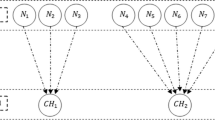Abstract
Reported measurements by sensor nodes in wireless sensor networks (WSNs) are subject to various anomaly due to sensor/node failures or some events in the environment. Resource scarcity in sensor nodes makes the implementation of sophisticated data anomaly detection techniques challenging in WSNs. We present a multivariate physics-based data anomaly detection technique in WSNs, and we implement the technique to measure the accuracy and efficiency of the proposed technique in detail. The proposed technique examines the natural relationship between various types of sensor measurements to determine the existence of any data anomaly in the node. Furthermore, the technique enables the distinction of data errors and events where a data anomaly is flagged. The technique does not require any exchange of information between neighboring sensor nodes or a central node for data anomaly detection. In a case study, we have applied the proposed technique on temperature and humidity sensor readings and have implemented using TI CC3200 Development Kit, TI BOOSTXL-SENSORS, and TI IMETER-BOOST. To evaluate the accuracy and efficiency of the technique, we have manufactured various data errors and events, measured required memory footage, and metered the amount to current consumption by a sensor node. The detailed analyses have confirmed the high accuracy and efficiency in detecting and separating data errors and environmental events.










Similar content being viewed by others
References
Karl H, Willig A (2007) Protocols and architectures for wireless sensor networks. Wiley, England
Atzori L, Iera A, Morabito G (2010) The internet of things: a survey. Comput Netw 54 (15):2787–2805
Karkouch A, Mousannif H, Moatassime HA, Noel T (2016) Data quality in internet of things. J Netw Comput Appl 73(C):57–81
Chandola V, Banerjee A, Kumar V (2009) Anomaly detection: a survey. ACM Comput Surv 41(3):15,1–15,58
Rassam MA, Zainal A, Maarof MA (2013) Advancements of data anomaly detection research in wireless sensor networks: a survey and open issues. Sensors 13:10087–10122
Kalayci I, Ercan T (2018) Anomaly detection in wireless sensor networks data by using histogram based outlier score method. In: 2018 2nd International Symposium on Multidisciplinary Studies and Innovative Technologies (ISMSIT), pp 1–6
Xie M, Hu J, Guo S, Zomaya AY (2017) Distributed segment-based anomaly detection with kullback-leibler divergence in wireless sensor networks. IEEE Trans Inform Forensics Secur 12(1):101–110
Amer M, Goldstein M, Abdennadher S (2013) Enhancing one-class support vector machines for unsupervised anomaly detection. In: Proceedings of the ACM SIGKDD workshop on outlier detection and description. ODD ’13, pp 8–15
Tang J, Chen Z, Fu AW, Cheung DW (2002) Enhancing effectiveness of outlier detections for low density patterns. 535–548
Shilton A, Rajasegarar S, Palaniswami M (2013) Combined multiclass classification and anomaly detection for large-scale wireless sensor networks. In: 2013 IEEE eighth international conference on intelligent sensors, sensor networks and information processing, pp 491–496
Goh J, Adepu S, Tan M, Lee ZS (2017) Anomaly detection in cyber physical systems using recurrent neural networks. In: 2017 IEEE 18th international symposium on High Assurance Systems Engineering (HASE), pp 140–145
Titouna C, Nait-Abdesselam F, Khokhar A (2019) A multivariate outlier detection algorithm for wireless sensor networks. In: ICC 2019 - 2019 IEEE International Conference on Communications (ICC)
Janakiram D, Reddy VA, Kumar AVUP (2006) Outlier detection in wireless sensor networks using Bayesian belief networks. In: 2006 1st International Conference on Communication Systems Software Middleware, pp 1–6
Li Y (2010) Anomaly detection in unknown environments using wireless sensor networks. PhD thesis, University of Tennessee
Intellisense systems. https://www.intellisenseinc.com/. [Online; accessed 22-July-2020]
Lakhiar IA, Jianmin G, Syed TN, Chandio FA, Buttar NA, Qureshi WA (2018) Monitoring and control systems in agriculture using intelligent sensor techniques: a review of the aeroponic system. Hindawi J Sens 1687-725X
Kyi S, Taparugssanagorn A (2020) Wireless sensing for a solar power system. Digit Commun Netw 6(1):51–57
Lowe PR, Ficke JM (1974) The computation of saturation vapor pressure. Environmental prediction research facility (Navy)
Murray FW (1966) On the computation of saturation vapor pressure. The RAND Corporation
Author information
Authors and Affiliations
Corresponding author
Additional information
Publisher’s Note
Springer Nature remains neutral with regard to jurisdictional claims in published maps and institutional affiliations.
Rights and permissions
About this article
Cite this article
Phillips, P., Afolabi, O.R. & Salmani, H. Experimental Data Anomaly Detection at Edge Sensor Nodes Using Physics Laws. J Hardw Syst Secur 5, 19–31 (2021). https://doi.org/10.1007/s41635-020-00101-1
Received:
Accepted:
Published:
Issue Date:
DOI: https://doi.org/10.1007/s41635-020-00101-1




